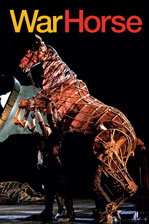
Warhorse, showing at the National Theatre in London, has some absolutely stunning life-size horse puppets, designed and made by Basil Jones and Adrian Kohler from the South African Handspring Puppet Company.
Made of cane and gauze, plywood and bicycle brake-cable, nylon cord and leather, they are moved from the inside by actors, who can clearly be seen through the horses’ skeletal bamboo frames; another human steers the head, so that the steeds nuzzle, twitch their ears, shiver with fear, rear in fright, roll their lustrous eyes; they also neigh and snicker. The actors are the inner lives of the beasts: when one horse dies, sinking to its knees and then lying, as a silvery grey skeleton, on its side, you see the puppeteers rolling out of the frame as if they were a band of souls leaving a body. After battle, the stage is covered in emptied carcasses, like dressmakers’ dummies. – Suzannah Clapp, review in The Guardian
The Guardian also has a gallery of images that tell the story, as well as providing the best photographs of the puppets that I have come across. Of course, much of the magic is in their movement: there is a glimpse of that in this ‘what the audience thinks’ video.
There are some other reviews at The Independent, Daily Telegraph, The Times, and the London Theatre Guide.
(via Puppetry News)
Previously:


